Registering Administrators Before Using the Machine
Administrators refers to special users who have the authority to manage various information and settings of the machine. To use the machine safely, register the administrators and allow only the administrators to configure the important settings such as registering users and the security settings.
Overview of the Administrator Privileges
For each function, there are four types of administrator privileges. You can assign all four privileges to one person, or assign a specific privilege to another person.
Types of the administrator privileges
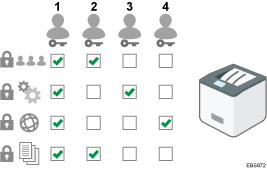
User Management: Manages information registered in the Address Book. You can add users to the Address Book and change the registered information.
Machine Management: Mainly manages the settings of the machine. You can configure the machine so that the settings can be changed only by the administrator.
Network Management: Manages the settings for connecting to the network.
File Management: Manages the permission to access the files stored on the optional hard disk. You can specify passwords so that only the owner or permitted users can view or edit them.
Sharing the administrator tasks facilitates each administrator's tasks and at the same time prevents unauthorized operations by administrators.
Workflow to register the administrator
Activating the Administrator Authentication.
Activate the Administrator Authentication function of the machine.
Logging in to the Machine as the Administrator
Enter the login user name and login password of the administrator to log in to the machine.
Registering or changing the administrator
Assign the privileges to each administrator. You can register up to four administrators.
![]()
The administrators are distinguished from the users registered in the Address Book. A Login User Name registered in the Address Book cannot be used as an administrator.
The supervisor has the privilege to manage the administrators. When the administrator is changed, the supervisor can reset the login password. There is only one supervisor.
Activating the Administrator Authentication
An administrator can manage the machine by activating the management function using Web Image Monitor.
![]() Launch the Web browser.
Launch the Web browser.
![]() Enter "http://(IP address of the machine or host name)/" on the address bar of the Web browser, and then press the Enter key.
Enter "http://(IP address of the machine or host name)/" on the address bar of the Web browser, and then press the Enter key.
![]() Log in to the machine as an administrator.
Log in to the machine as an administrator.
![]() Click [Configuration] from the [Device Management] menu.
Click [Configuration] from the [Device Management] menu.
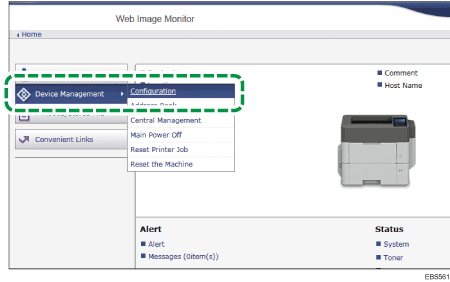
![]() Click [Administrator Authentication Management] in the "Device Settings" category.
Click [Administrator Authentication Management] in the "Device Settings" category.
![]() Select [On] on the administrator privilege to activate administrator authentication.
Select [On] on the administrator privilege to activate administrator authentication.
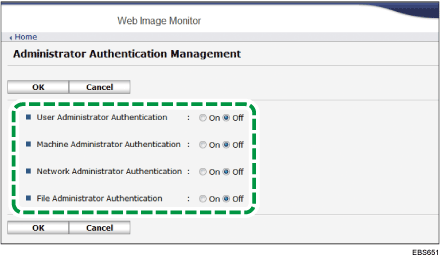
![]() Click [OK] and exit the Web browser.
Click [OK] and exit the Web browser.
Logging in to the Machine as the Administrator
Log in to the machine as an administrator on the control panel.
To log in to the machine for the first time, login as Administrator 1. Refer to the provided guide for the Login User Name and Login Password.
![]() Press the [Menu] key.
Press the [Menu] key.
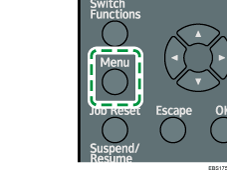
![]() Press the selection key beneath [Enter].
Press the selection key beneath [Enter].
![]() Press the [
Press the [![]() ] or [
] or [![]() ] key to select a character for your login user name, and then press the [OK] key to enter the character. Repeat this to complete your login user name, and then press the selection key beneath [Accept].
] key to select a character for your login user name, and then press the [OK] key to enter the character. Repeat this to complete your login user name, and then press the selection key beneath [Accept].

To enter upper-case letters, numerals, or symbols, press the selection key beneath [ABC/123].
To delete a character that has been entered, press the selection key beneath [Delete].
![]() Press the selection key beneath [Enter].
Press the selection key beneath [Enter].
![]() Follow the instructions in Step 4 to enter the login user password, and then press the selection key beneath [Accept].
Follow the instructions in Step 4 to enter the login user password, and then press the selection key beneath [Accept].
To register or change an administrator other than yourself, follow the procedures described in Adding Administrators or Changing the Privileges.
![]() After completing the procedure, press the selection key beneath [Logout].
After completing the procedure, press the selection key beneath [Logout].
![]()
If you log in using administrator privileges, the name of the administrator logging in appears. When you log in with a user name that has multiple administrator privileges, one of the administrator privileges associated with that name is displayed.
Adding Administrators or Changing the Privileges
You can register up to four administrators. All four registered personnel can have all administrator privileges. To reduce the administrator's load, the four registered personnel can share the administrator privileges.
Discuss the number of users to add and privileges to give in advance, decide the Login User Name and Login Password for Administrator 2 to Administrator 4, and configure the settings.
![]()
Do not forget the Login User Name and Login Password of the administrators added.
An administrator cannot change the login user names and passwords for other administrators.
![]() Log in to the machine as the administrator from Web Image Monitor.
Log in to the machine as the administrator from Web Image Monitor.
![]() Click [Configuration] from the [Device Management] menu.
Click [Configuration] from the [Device Management] menu.

![]() Click [Program/Change Administrator] in the "Device Settings" category.
Click [Program/Change Administrator] in the "Device Settings" category.
![]() Select an administrator to assign for each of the administrator privileges.
Select an administrator to assign for each of the administrator privileges.
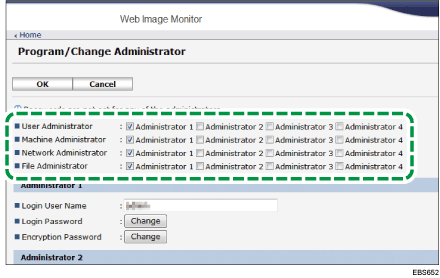
Assign the privileges of "User Administrator", "Machine Administrator", "Network Administrator", or "File Administrator" to [Administrator 1] to [Administrator 4].
By default, all privileges are assigned to the login administrator (Administrator 1).
Administrator privileges assigned to a person can be shared with another person.
![]() Enter the Login User Name of Administrator 1 to Administrator 4.
Enter the Login User Name of Administrator 1 to Administrator 4.
![]() Click [Change] next to "Login Password" on each of the administrators.
Click [Change] next to "Login Password" on each of the administrators.
![]() Enter the login password in "New Password".
Enter the login password in "New Password".
![]() Re-enter the login password in "Confirm Password", and then click [OK].
Re-enter the login password in "Confirm Password", and then click [OK].
When you manage the machine with software supporting SNMPv3 such as Device Manager NX, you have to specify the password to encrypt communication.
![]() Click [OK] and exit the Web browser.
Click [OK] and exit the Web browser.
When settings are complete, the machine is automatically logged out.
Take note of the Login User Name and Login Password specified for the other administrators and inform them to the administrator.
Notes when specifying the login user name and password
The following characters can be used for login user names and passwords. Names and passwords are case-sensitive.
Upper case letters: A to Z (26 characters)
Lower case letters: a to z (26 characters)
Numbers: 0 to 9 (10 characters)
Symbols: (space) ! " # $ % & ' ( ) * + , - . / : ; < = > ? @ [ \ ] ^ _` { | } ~ (33 characters)
Login user name/ password | Explanation |
|---|---|
Login user name |
|
Login password |
|
Changing the Supervisor
This section describes how to change the supervisor's login user name and password.
To do this, you must enable the user administrator's privileges through the settings under "Administrator Authentication Management".
Adding Administrators or Changing the Privileges
![]() Log in to the machine as the supervisor from Web Image Monitor.
Log in to the machine as the supervisor from Web Image Monitor.
![]() Click [Configuration] from the [Device Management] menu.
Click [Configuration] from the [Device Management] menu.
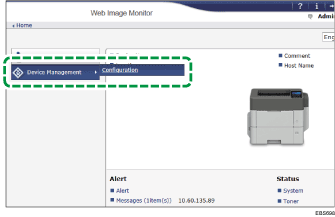
![]() Click [Program/Change Administrator] in the "Device Settings" category.
Click [Program/Change Administrator] in the "Device Settings" category.
![]() Enter the Login User Name of Supervisor.
Enter the Login User Name of Supervisor.
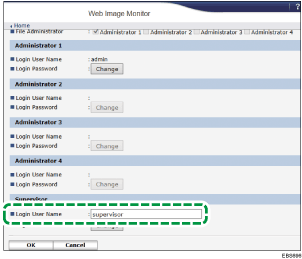
![]() Click [Change] next to "Login Password".
Click [Change] next to "Login Password".
![]() Enter the login password in "New Password".
Enter the login password in "New Password".
![]() Re-enter the login password in "Confirm Password", and then click [OK].
Re-enter the login password in "Confirm Password", and then click [OK].
![]() Click [OK] and exit the Web browser.
Click [OK] and exit the Web browser.
When settings are complete, the machine is automatically logged out.
Changing the Password of an Administrator
Only the supervisor has the privilege to change the password of the administrator. If an administrator forgets the password or wants to change the password, the supervisor must reset the password.
Refer to the provided guide for the Login User Name and Login Password of the supervisor.
![]()
Do not forget the Login User Name and Login Password of the supervisor. If you forget these, you have to restore the factory default settings, which will result in loss of data.
![]() Log in to the machine as the supervisor from Web Image Monitor.
Log in to the machine as the supervisor from Web Image Monitor.
![]() Click [Configuration] from the [Device Management] menu.
Click [Configuration] from the [Device Management] menu.

![]() Click [Program/Change Administrator] in the "Device Settings" category.
Click [Program/Change Administrator] in the "Device Settings" category.
![]() Click [Change] next to "Login Password" on the administrator whose password you want to reset.
Click [Change] next to "Login Password" on the administrator whose password you want to reset.
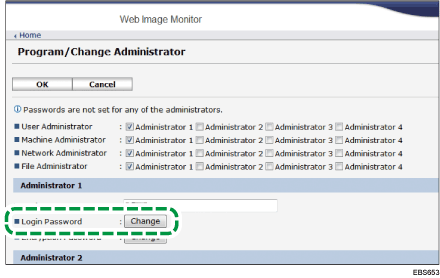
![]() Enter the login password in "New Password".
Enter the login password in "New Password".
![]() Re-enter the login password in "Confirm Password", and then click [OK].
Re-enter the login password in "Confirm Password", and then click [OK].
![]() Click [OK] and exit the Web browser.
Click [OK] and exit the Web browser.
When settings are complete, the machine is automatically logged out.

